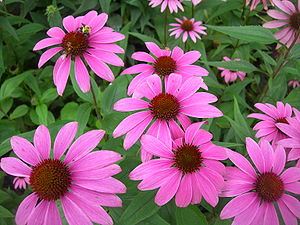- Image via Wikipedia –Echinacea, coneflower
Echinacea is a perennial herb that is native to the grasslands of North America and a member of the aster family, Asteraceae. The asters, as a group, have daisy-like composite flowers consisting of ray flowers, which appear to be the petals of a single large flower, and small disc flowers, which are in the center of the circular flower head.
Echinacea grows two to four feet tall with each stem bearing a single composite flower at the top. Stems are squarish and sturdy. The pink to purple ray flowers that surround the central disc flowers suggest its common name, the purple coneflower. The flower color ranges from bright, hot pink in some plants to a pale, softer pink in others.
Three species of Echinacea are popular with gardeners and herbalists. E. purpurea, the purple coneflower, has large oval leaves with ragged, coarsely toothed edges and a rough texture. The disc flowers are bristly and tipped with orange. E. pallida, the pale purple coneflower, has softer, more narrow leaves with parallel veins and drooping ray flowers that are quite thin and swept back. E. angustifolia, the narrow-leaved purple coneflower, also has parallel leaf veins, but it only grows to 20 inches tall with ray flowers that are about as long as the disc is wide.
The disc flowers bloom and fade in sequence with the outermost ones blooming first. As they start to develop their seeds the central disc enlarges from a flat disc shape into a larger cone shape, hence the name coneflower. The seed cones will last well into winter and are a great source of food for small birds such as wrens, goldfinches, house finches and tufted titmouses.
Echinacea leaves, flowers and roots are used in herbal teas, the taste of which is improved by blending with licorice root, peppermint or orange rind. Stevia and honey are natural sweeteners that go well with herbal teas like echinacea.
Echinacea tea may be effective in treating symptoms of the common cold and in strengthening the immune system depending on the formulation. All species are used for this purpose, but E. purpurea is used most extensively in commercial preparations. Native Americans used echinacea to treat many different ailments, including bites, cancers, wounds, sores, colds and influenza. A poultice of the chewed root or tea-soaked gauze makes a wonderful drawing agent for bites, stings, boils, abscesses and other skin irritations. Modern science confirms the insecticidal, antibacterial and immune system stimulating properties, but its effectiveness for treating the common cold is debated.

